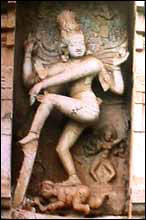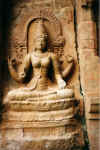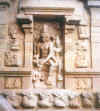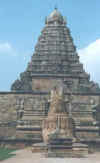Gangaikonda Cholapuram
Gangaikonda
Cholapuram is about 60km from Chidambaram, in the Udaiyarpalayam taluk of Tiruchi
district of Tamilnadu, situated by the Chennai-Tanjavur
highway. Gangaikonda Cholapuram was erected in about 1020 A.D. by Rajendra I, the son and successor of
Rajaraja I, probably to commemorate his victorious march to the Ganges. This was erected as the capital of the
Chola empire that extended from the Tungabhadra in the north to Ceylon in the south
and remained so for about 250 years.
and successor of
Rajaraja I, probably to commemorate his victorious march to the Ganges. This was erected as the capital of the
Chola empire that extended from the Tungabhadra in the north to Ceylon in the south
and remained so for about 250 years.
The temple is dedicated to Shiva. The sanctum tower is very large and second only to that of the temple of Tanjavur. The imposing Vimana with its recessed corners and upward movement presents a striking contrast to the straight-sided pyramidal tower of Tanjavur. It rises to a height of 160 feet. The temple of Gangaikondacholisvara is approached through the northern entrance. The temple has beautiful sculptures of Shiva, Parvati and Saraswati. The lingam is one of the largest in Southern India. The temple also has some excellent bronzes of Chola period.
Architectural details
The Vimana of the temple is flanked on either side by small temples; in the north is the shrine of Goddess and of Chandikesvara. In the north-east are a shires of Durga and Simhakeni (lion-well) - a circular well with steps with head of a lion carved at the entrance at the western end. According to tradition Rajendra I poured a part of the Ganges water brought from his famous expedition into the well to sanctify it. A mandapam, Nandi facing the main shrine and a ruined gopuram is in the east.
To the west is a shrine, of later Chalukyan period construction, is the shrine for Mahishasuramardini.
The
shrine to the south of the Vimana is known as the southern
Kailasa has a sanctum preceded by a mandapam with flights
of steps from south and north. Only the basement remains now. The outer walls
of the sanctum and mandapam carry
 niches, housing images of Dakshinamurthi, Lingodhbhava, Ganesa, Nataraja, Bhikshatana
Subrahmanya, Gauriprasada, Durga, Ardhanariswara and Bhirava. The inner sanctum of the
shrine is now in ruins.
niches, housing images of Dakshinamurthi, Lingodhbhava, Ganesa, Nataraja, Bhikshatana
Subrahmanya, Gauriprasada, Durga, Ardhanariswara and Bhirava. The inner sanctum of the
shrine is now in ruins.
To the north-east of this temple is the ruins of Alankara mandapam.
To the north of the main temple is a small shrine housing the Goddess, Brhannayaki, the consort of Lord Gangaikondacholisvara and is known as Uttara Kailasa. As in the southern Kailasa, there are images of Ganesa, Nataraja, Bhikshatana, Subrahmanya, Dakshinamurti, Lingodhbhava, Brahma, Bhairava, Ardhanari, Durga, and Gauriprasada, a sculpture of bearded Brahma is also in this temple.
The little temple to the north-east is of chandikesvara, the steward of Siva. It is an all stone temple. Chandikesvara is the principal subsidiary deity in Siva temples and till about 13th century A.D. all the transactions relating to the temple were made in his name.
The main temple
The main temple consists of a sanctum tower called Sri Vimana or Sri koil, a big rectangular mandapam called the mahamandapam with an intervening vestibule called mukhamandapam.
The Sri Vimana consists of the following parts beginning with the lowest basement.
basement (upa-pitha)
base (adishthana)
wall (bhithi)
roof cornice (prasthara)
garland of miniature shrines (haara)
stories (thala or bhumi)
neck (griva)
crown (sikhara)
final (stupi).
According to architectural treatises, basements (upa-pithas) are introduced in temples to increase the height of the main tower; to add to structural stability and to make the temple tower imposing, this may be noticed even by a casual visitor not conversant with architectural aspects. These purposes are magnificently fulfilled by the basements of both the Tanjavur temple and Gangaikondacholapuram temple. Besides, this the basement also provides space to walk around the tower. Here, the basement is ornamented with sculptures of lions.
The main base adishthana is decorated with well defined courses, consisting of the lotus molding adaspadma, and the kumuda molding, topped by a frieze of lions and riders. This constitute the main base, the top of which forms the flooring level of the inner sanctum.
That portion of the structure rising above the main base up-to
the roof cornice is called 'the wall' (bhithi or kal). It is the principal
element that encases the main sanctum and carries on it a number of niches
housing various deities. The wall in this temple is divided into two horizontal
courses by an intervening cornice. The lower and upper courses have an equal
number of niches, on all the three sides except the front.
sanctum and carries on it a number of niches
housing various deities. The wall in this temple is divided into two horizontal
courses by an intervening cornice. The lower and upper courses have an equal
number of niches, on all the three sides except the front.
On the vertical axis the wall surfaces are well defined by intervening recesses forming a rectangle in the center and squares at the corners. Each is made up of a central niche housing a deity, flanked by a group of small sculptures which in turn are flanked by pilasters simulating pillars. Thus each niche housing a deity appears as a miniature shrine. The recessed walls in the lower courses carry a vase and pilaster ornamentation, while on the upper courses carry a vase and pilaster ornamentation, while on the upper courses, there are small niches housing deities. Thus there are five principal deities in the lower course and nine deities in the upper course on each side. Since the mukhamandapa abuts the eastern wall, only one niche is retained in the lower course. On either side of the eastern wall, the upper course retains the principal niche at the corners and smaller niches at the recessed walls.
The sculptures in the lower
courses, of the Sri Vimana, depict
various aspects of
 Siva and also the subsidiary deities
which include Ganesa,
Vishnu, Subrahmanya, Durga, Brahma, and Bhairava, supplemented by Lakshmi,
Saraswati, and Durga in the niches of the great mandapa. The sculptures were
made separately and fitted into the niches. They are flanked by a group of small
sculptures, carved in situ, illustrating the theme the niche sculpture seeks to
represent. The sculptures on the upper courses represent, besides some aspects
of Siva, the guardian deities of the eight quarters.
Siva and also the subsidiary deities
which include Ganesa,
Vishnu, Subrahmanya, Durga, Brahma, and Bhairava, supplemented by Lakshmi,
Saraswati, and Durga in the niches of the great mandapa. The sculptures were
made separately and fitted into the niches. They are flanked by a group of small
sculptures, carved in situ, illustrating the theme the niche sculpture seeks to
represent. The sculptures on the upper courses represent, besides some aspects
of Siva, the guardian deities of the eight quarters.
The roof cornice consists mainly of three parts:
the frieze of dwarfs at the bottom,
the cornice forming the outer edge of the ceiling roof proper
the frieze of leogriffs on the top.
The cornice is decorated with plain spade-like ornamentation topped by the head of a leogriff.
A row of miniature shrines runs around the tower like a garland, and is called a haara. It consists of square pavilions at the corners, rectangular pavilions in the middle, with a nest (nida) ornamentation in between.
Above this rise the main tower, consisting of nine stories including the ground floor. The upper stories of the main tower carry the same type of ornamentation, consisting of square and oblong pavilions except a change; the central wagon-shaped pavilion is flanked by square ones instead of "the nests", the whole being projected forward than the rest. This is a change from the Tanjavur tower, which presents a pyramidal appearance without the central projection.
The neck is provided with four niches in the cardinal directions and bulls at the corners. The niches are topped by arch-like embellishment called kirtimukhas.
 The globular element on the top called Sikhara is according to
tradition, made of single stone weighing many stones. But, in fact, it is made of
many pieces of cut stones dressed for the purpose, as may be seen from the
portion where the plaster has fallen down.
The globular element on the top called Sikhara is according to
tradition, made of single stone weighing many stones. But, in fact, it is made of
many pieces of cut stones dressed for the purpose, as may be seen from the
portion where the plaster has fallen down.
The final, stupi is a metal vase with a lotus-bud design at the top. It is gilded with gold and is said to carry an inscription named after Nallakka-tola-udayar, a Poligar of Udayarpalaiyam. It is not known whether the stupi is the original one and probably guilded by the Poligar or is a new one gifted by him.
The sanctum enshrining the main deity, is encased by an inner wall. Between the inner wall and the outer, there is an intervening passage-called sandhara running all around. The two walls are joined at the top by a series of corbelling. They are provided to support the massive super-structure. In the great temple of Tanjavur, the outer walls have openings in the centre leading into the intervening passage. Facing the openings are sculptures of deities. The inner faces of the passage are painted with scenes depicting exploits of Siva and his devotees. But in Gangaikondacholapuram, there are no painting in the inner passage. The central openings and corresponding sculptures, are also not there. This inner passage around the sanctum is also found on the first floor. In the Tanjavur temple the inner wall of this passage carries 108 poses of dancing Siva, of which 83 are fully finished and the rest are incomplete. But in Gangaikondacholapuram no such sculptural representation is noticed.
The inner sanctum, houses a Siva Lingam of thirteen feet height. It is said to be the biggest Siva Lingam in any sanctum of South Indian temple. The entrance to the sanctum is guarded by massive doorkeepers, dwarapalas.
The mandapam immediately preceding the sanctum is approached by steps leading to it from the north and the south sides and also from the great mandapam in the east. The entrances are guarded by big dwarapalas of remarkable beauty. The mandapam is supported by massive plain and square pillars. The eastern walls flanking the opening to the great mandapam carry groups of small sculptures illustrating Shivaite themes.
The following are the themes represented.
Episode of Ravana traveling in his chariot shaking the Kailasa mountain
Siva seated with Uma, pressing the mountain with his toe
Ravana's anguish under the weight of the mountain and finally Siva bestowing boons on Ravana
The second episode on the same wall depicts Vishnu, worshipping Siva with 1008 lotus flowers, plucking his own eye and offering it as a flower onfinding one flower short. Siva bestows grace on Vishnu. The panels closer to the entrance depict the marriage of Siva with Uma. Uma, the daughter Himavan, desirous of marrying Siva, undertakes austerities and worships Siva; who tests her steadfastness as a beautiful youth and, marries her.
The eastern wall, close to the entrance on the northern side, depicts the Kiratarjuna scene; Arjuna the Pandava hero performs austerities to obtain a Pasupata weapon; Siva as a hunter accompanied by Uma as a huntress, tests Arjuna's devotion; picks up a quarrel with Arjuna over a kill; Arjuna not knowing the personality behind the hunter, enters into a duel with him and is ultimately vanquished; Siva manifest himself and bestows the weapon.
At the extreme north in the same side are portrayed two episodes, one representing Siva quelling the pride of God of death, in order to protect his devotee and the other representing Saint Chandikeswara a great devotee of Siva, cutting off the leg of his father, who disturbed his faith and Siva bestowing grace on both father and son.
Though these group sculptures are carefully selected, they are imperfectly finished and lack beauty and elegance of the sculptures of the main tower.
The Mahamandapa
Had the original mahamandapa been preserved, it would have retained the grandeur of its conception and beauty. But as it is, only the portion up to the main base is original. The side walls, the pillars and the ceilings have been reconstructed, probably in the 18th century A.D. Obviously the superstructure should have crumbled due to neglect and vegetation.
However a part of the original has survived up to the ceiling leel at the western end. From the surviving portion it may be seen, the roof (prastara) of the mahamandapa was in level with the prastara of the ground floor (adi bhumi) of the main Vimana. Like the walls of the main Vimana, a horizontal cornice divides the outer walls of the mahamandapa into two parts. They carry a series of niches both in the upper and lower courses.
The sculptures of Vidyesvaras, Vasus, Adityas and other subsidiary deities were probably enshrined in them. As mentioned earlier, the adibhumi of the main Vimana has two floors inside the sandhara passage, the intervening cornice forming the intermediate floor level. The mahamandapa should have been a two storeyed pavilion, quite fitting with the mahaprasada of the temple. In view of the tall dvarapalas guarding the entrance to the mukhamandapa, the central passage could have had only the upper ceiling without the intermediate flooring. Thus the central passage was flanked by two storied structures, resembling the storied cloister of the enclosure. It is likely that the mahamandapa of Tanjavur which was also a two storied structure originally.
A room at the south western corner houses a beautiful Somaskanda image and a few other bronzes. A few sculptures and bronzes receiving regular worship are on the northern platform. The north eastern corner houses an interesting Solaar aal-thara, now worshipped as navagrahas (nine planets).
The front entrance to the great mandapam, is approached by steps from north and south. The entrance to the mandapa is guarded by massive dwarapalas. As the flooring of the mandapam is on a high elevation, the stpes rise to a considerable height forming a high platform in the front. It is said that there is a sub-terrain passage with steps under this platform. Some claim that this passage leads to the royal palace, while others assert that it leads to the river Kollidam. Yet a third tradition says that it leads to an underground treasury wherein invaluable properties belonging to the temple are preserved.
No one enters this dark passage for fear of poisonous gases and wasps. It is likely that the empty underground space below the great mandapam and the space between the steps, were utilised as store houses.